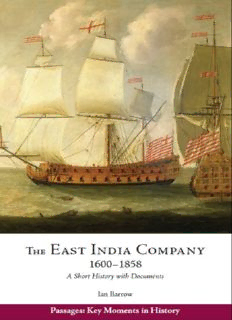
The East India Company, 1600–1858: A Short History with Documents PDF
Preview The East India Company, 1600–1858: A Short History with Documents
PASSAGES: KEY MOMENTS IN HISTORY The East India Company, 1600–1858 A Short History with Documents PASSAGES: KEY MOMENTS IN HISTORY The East India Company, 1600–1858 A Short History with Documents Ian Barrow Hackett Publishing Company, Inc. Indianapolis/Cambridge Copyright © 2017 by Hackett Publishing Company, Inc. All rights reserved Printed in the United States of America 20 19 18 2 3 4 5 6 7 For further information, please address Hackett Publishing Company, Inc. P.O. Box 44937 Indianapolis, Indiana 46244-0937 www.hackettpublishing.com Cover design by Rick Todhunter Interior design by Laura Clark Maps by Beehive Cartography Composition by Aptara, Inc. Library of Congress Cataloging-in-Publication Data Names: Barrow, Ian J., author. Title: The East India Company, 1600/1858 : a short history with documents / Ian Barrow. Description: Indianapolis : Hackett Publishing Company, Inc., [2017] | Series: Passages: Key moments in history | Includes bibliographical references and index. Identifiers: LCCN 2016047052 | ISBN 9781624665967 (pbk.) | ISBN 9781624665974 (cloth) Subjects: LCSH: East India Company—History. | East India Company— History—Sources. | British—India—History—Sources. Classification: LCC DS465 .B38 2017 | DDC 382.0941/05—dc23 LC record available at https://lccn.loc.gov/2016047052 epub ISBN: 978-1-62466-611-7 TITLE OF RELATED INTEREST AVAILABLE FROM HACKETT PUBLISHING R. Po-chia Hsia, Matteo Ricci and the Catholic Mission to China, 1583- 1610: A Short History with Documents. CONTENTS The page numbers in curly braces {} correspond to the print edition of this title. Acknowledgments Chronology Glossary List of Maps List of Illustrations Introduction Chapter One: The Seventeenth Century Chapter Two: The Eighteenth Century Chapter Three: The Nineteenth Century Conclusion Documents 1. The Company’s Accusations against the Dutch East India Company (1624) 2. Domestic Opposition to the East India Company (1681) 3. Criticism of a Company Bigwig and His War against the Mughal Empire (1690) 4. English Opposition to Importing Cotton Textiles (1708) 5. An Early View of Bencoolen, the Company’s Pepper Port (1727) 6. Asserting the Company’s Power over Defeated Enemies (1765) 7. Exposing the Company’s Mismanagement (1772) 8. An Erotic Encounter (1789) 9. The Spectacle of Tipu Sultan’s Death (1799) 10. Arguments for Opening India to Missionaries (1805) 11. An Anti-Missionary Perspective (1808) 12. A British Prisoner of War Returns Home from India (1824) 13. Advice to a Young Company Employee Traveling to India for the First Time (1827) 14. Missionary Sentiments (1830) 15. A Lady’s Arrival in Calcutta (1820s; 1850) 16. Touring India (1837; 1866) 17. The Beginning of a Disastrous War (1838) 18. First Reactions in Britain to the News of the Rebellion (1857) Select Bibliography Index Titles of Related Interest Available from Hackett Publishing {VII} ACKNOWLEDGMENTS It has taken more than two years to research and write this book. My greatest debt goes to my wife, Dana, for her patience as I (endlessly) chatted about the seventeenth and eighteenth and nineteenth centuries, for her encouragement whenever I ran out of steam, and, most importantly, for her love. Along the way friends and colleagues have offered generous support and invaluable advice by reading the manuscript, discussing the ideas behind the book, or sharing their enthusiasm for the project. A heartfelt thank you to Andrew Amstutz, Febe Armanios, Michelle Baird, Hayden Bellenoit, Vivek Bhandari, Dan Brayton, Nat Caldwell, Maggie Clinton, Boğaç Ergene, Philip Gould, Rebekah Irwin, Maya Joshi, Adam Lougee, Joyce Mao, Sonali Mishra, Paul Monod, Cynthia Packert, Sumathi Ramaswamy, Mark Rogers, Awadhendra Sharan, and Kurt Suchomel. While writing the book I had my students in mind and I often shared drafts with my classes. The suggestions they offered were invariably thoughtful. Three anonymous reviewers provided detailed and helpful comments and I thank them for the considerable time they spent reading the manuscript and drafting their responses. Much of the writing was conducted while I was on sabbatical and I am grateful to Middlebury College for giving me that time. The book was first imagined in a conversation with Rick Todhunter on a cold winter’s afternoon in Vermont. Ever since that serendipitous meeting, he has been an exemplary editor while his colleague Liz Wilson has expertly shepherded the book through production. This book is dedicated to my mother, Yvonne. When I was a little boy she very often took me to visit castles, country estates, and museums spread across England and Wales. They were glorious trips, and since then she has never stopped sharing her delight in seeing and learning about the past. I could not have written this book without her love, inspiration, and encouragement. {VIII} CHRONOLOGY 1600 East India Company established 1601 First voyage sails for the Spice Islands Dutch East India Company (VOC) established The English 1602 company establishes a factory at Bantam 1613 Factory established at Surat Sir Thomas Roe travels to the Mughal 1615–19 court 1623 Amboyna “massacre” Courteen’s Association granted a charter 1635 by Charles I 1639 Factory established at Madras 1657 Permanent joint stock established Charles II transfers control over Bombay 1668 to the Company Bencoolen becomes new center for the export of pepper (after the Dutch 1685 expel the Company from Bantam in 1682) 1686–90 Company’s war with the Mughals 1690 Factory established at Calcutta Establishment of a rival English East 1698 India company Merger of the two English East India 1709 companies 1746 Madras captured by the French
Description: